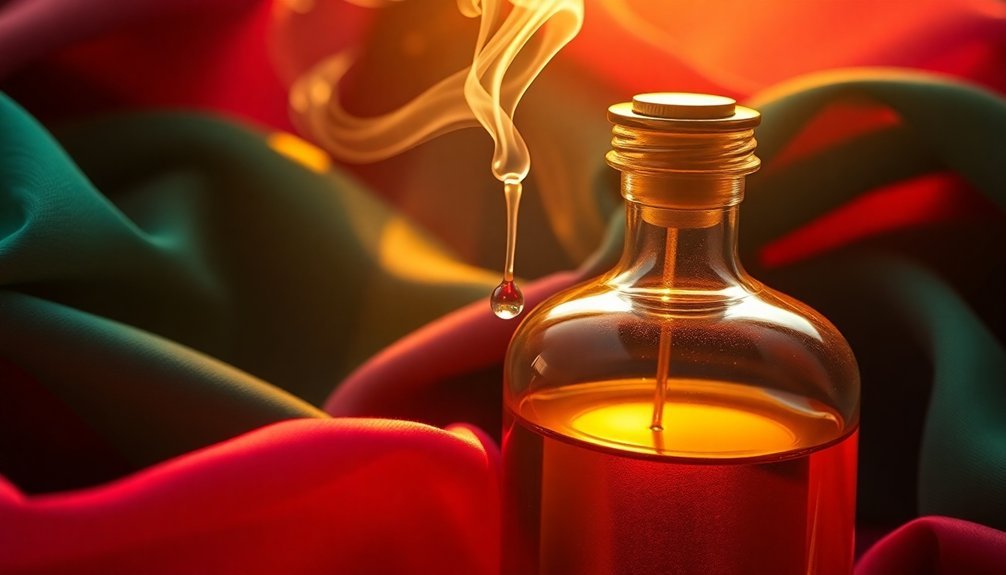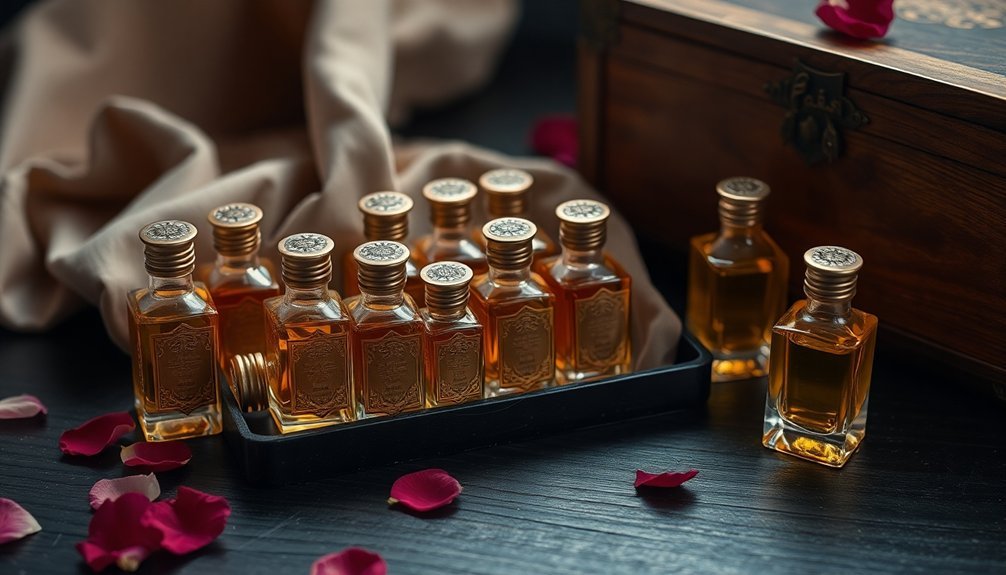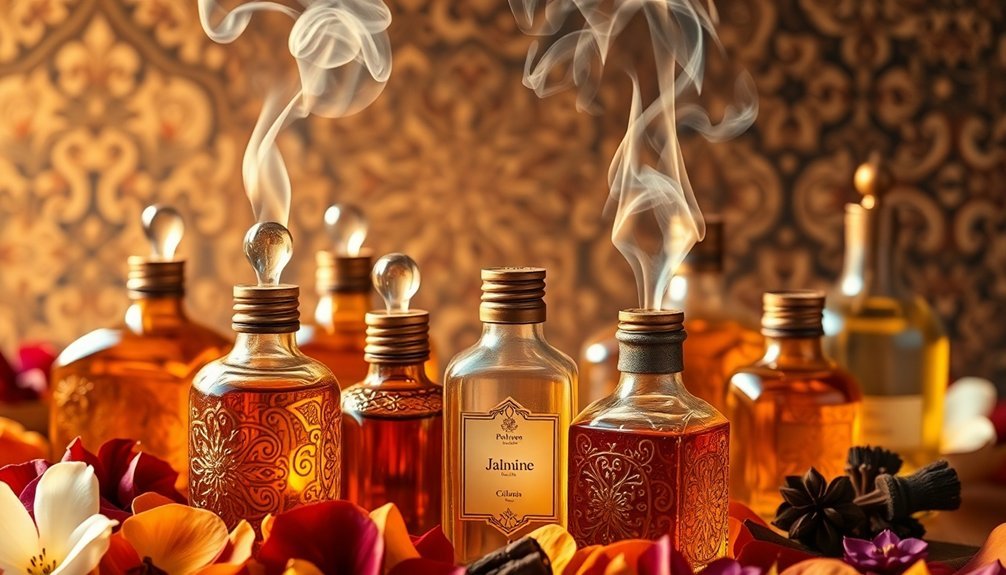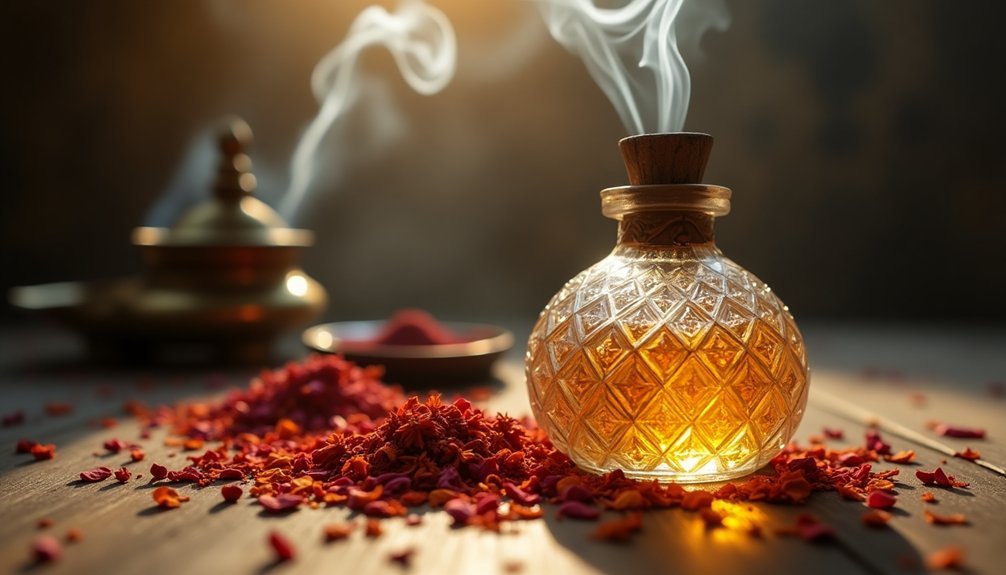Middle Eastern perfume oils captivate you through their time-honored craftsmanship and sacred ingredients. You'll discover complex layers of precious oud, Damascus rose, and ancient resins that evolve uniquely on your skin throughout the day. These alcohol-free blends carry deep cultural significance, with some ingredients dating back three millennia. When you master the art of proper layering and application, you'll reveal the full mystique of these enchanting fragrances.
The Ancient Art of Middle Eastern Perfumery

The art of Middle Eastern perfumery stands as one of humanity's oldest and most sophisticated aromatic traditions. While it has roots in ancient Egyptian practices, it was in the Arabian Peninsula where these techniques were truly mastered and elevated to new heights.
You'll find that this craft evolved through centuries of meticulous development, with perfumers documenting their treasured recipes in temple texts. Ancient Egyptians developed their perfumes through three main extraction techniques.
They've refined processes like distillation, maceration, and layering to create complex fragrances that tell stories on your skin. What makes these perfumes unique is their oil-based composition, requiring extensive preparation times – sometimes up to two years for a single batch.
The attention to detail is remarkable, from making astringent bases with herbs and spices to carefully calculating exact quantities during the reduction process.
Sacred Ingredients That Define Arabian Scents
You'll discover how agarwood's prized oud essence has captured imaginations for centuries with its deep, mysterious character and royal legacy.
The legendary Damascus rose brings its rich floral poetry to countless Arabian perfumes, creating an unmistakable signature in traditional Middle Eastern scents. Natural ingredients dominate these precious fragrances, preserving their authenticity and purity through generations of expert craftsmanship.
Sacred resins like frankincense and precious spices infuse these oils with spiritual significance, connecting modern perfumery to ancient aromatic traditions.
Ancient Oud's Mystical Legacy
Dating back over three millennia, oud's mystical legacy stands as a cornerstone of Middle Eastern culture, spirituality, and luxury perfumery.
You'll find this precious ingredient, worth more than its weight in gold, deeply woven into the fabric of Islamic tradition. When you enter a mosque or attend Friday prayers, you're likely to encounter its distinctive aroma, as it's considered a divine connection and spiritual cleanser.
Through ancient trade routes from China to Arabia, oud has evolved from mere incense to become an essential part of Middle Eastern hospitality. You'll experience it as a gracious welcome gesture in social gatherings, and you'll notice its presence in significant celebrations like weddings and Eid festivities.
This "Wood of the Gods" continues to captivate the global fragrance market, with projections reaching $64 billion by 2029. The allure of oud has sparked a surge in global demand, leading to endangered aquilaria trees in Southeast Asia.
Precious Rose of Damascus
Revered as a divine essence, Damascus Rose stands as the crown jewel of Middle Eastern perfumery, enchanting perfume artisans and enthusiasts for millennia.
You'll discover its intense floral burst masterfully balanced with spicy caraway and earthy vetiver, creating a symphony of scents that tell stories of ancient traditions and cultural refinement.
When you wear this precious oil, you're embracing more than just a fragrance – you're connecting with centuries of Middle Eastern heritage where rose oils symbolize love, status, and celebration.
The natural, alcohol-free blend evolves uniquely on your skin, revealing complex layers of musk, Olibanum, and Labdanum.
- Imagine walking through Damascus's historic rose gardens at dawn
- Picture delicate rose petals being hand-harvested by skilled artisans
- Envision ancient perfumers carefully extracting precious oils using time-honored techniques
Sacred Resins and Incense
Deep within the heart of Middle Eastern perfumery lies a treasure more precious than gold – frankincense, the sacred resin that has shaped Arabian scents for over 5,000 years.
You'll find this precious substance in two distinct grades: the light-colored variety for internal use, rich in boswellic acids, and the darker type prized for its aromatic properties in incense.
When you explore Middle Eastern fragrances, you'll discover how frankincense blends beautifully with other sacred resins like benzoin, known for its vanilla-tinged smokiness, and myrrh, with its warm cinnamon notes.
These resins aren't just aromatic – they're fixatives that help create long-lasting, complex perfumes.
They're also deeply woven into religious ceremonies and daily life, representing luxury and tradition in Arabian culture.
The Magic of Oud in Traditional Blends
You'll find oud's royal heritage deeply woven into Middle Eastern perfumery, where it has adorned the necks of sultans and sheikhs for centuries.
When you wear oud-based fragrances, you're carrying forward an ancient tradition that symbolizes prestige and refinement in Arabian culture.
The seductive power of oud lies in its remarkable longevity, as its rich, woody aroma can enchant for hours, transforming gradually on your skin throughout the day.
Royal Heritage of Oud
Throughout the ages, oud has maintained its prestigious status as the cornerstone of Middle Eastern perfumery, earning its nickname 'black gold' due to its value rivaling that of precious metals.
You'll find this treasured ingredient's royal legacy traced back to ancient times, when prophets and nobles used it to perfume their garments and households. From its early Chinese origins to its prominence along the Silk Road, oud has evolved into a symbol of sophistication that's deeply woven into Islamic heritage.
- Picture yourself in a royal palace, where burning oud chips release their mesmerizing aroma
- Imagine receiving an exquisite oud-based perfume as a prestigious gift, following centuries-old traditions
- Envision ancient trade caravans carrying this precious commodity across vast deserts and mountains
This royal connection continues today, as you'll find oud in the world's most luxurious fragrances.
Oud's Seductive Lasting Power
The seductive allure of oud lies in its remarkable staying power, a quality that stems from its complex chemical composition.
When you apply oud to your skin, its resinous compounds, like agarospirol and jinkoh-eremol, begin a slow dance of evaporation that can last throughout your day.
You'll notice how this precious oil bonds naturally with your skin's chemistry, creating a unique fragrance signature that's distinctly yours.
The slow-releasing compounds work in harmony with your body's natural oils, ensuring you'll maintain that mysterious, woodsy aroma for hours.
Unlike lighter fragrances that quickly fade, oud's molecular structure allows it to anchor itself to your skin, gradually releasing its complex bouquet of sweet, smoky notes that make it worth more than its weight in gold.
Mastering the Layering Technique

Mastering the art of fragrance layering requires understanding both traditional Middle Eastern techniques and modern application methods.
You'll want to start with heavier scents like oud as your foundation, allowing them to settle on your skin before adding lighter notes. This ancient practice creates a complex, personalized fragrance that evolves throughout the day.
To achieve the perfect blend, apply your oils strategically to these pulse points:
- Behind your ears, where the warmth of your skin releases the scent gradually
- Along your wrists, creating an aromatic trail as you move
- At the base of your throat, allowing the fragrance to rise naturally
Remember to wait between layers and avoid over-application.
Your unique skin chemistry will interact differently with each oil, so experiment until you find your signature combination.
Creating Your Signature Oriental Blend
Creating your signature Oriental blend begins with understanding the interplay between essential base notes like oud and amber. You'll want to layer your fragrances strategically, starting with the heaviest notes and building up to the lighter ones.
| Base Notes | Top Notes |
|---|---|
| Oud | Rose |
| Amber | Orange Blossom |
| Musk | Jasmine |
| Frankincense | Saffron |
To craft your unique scent, start by applying a small amount of your chosen base oil, like oud or amber, to your pulse points. Let it settle for a few minutes before adding lighter notes. You can experiment with different combinations of attar oils and aromatic resins until you find your perfect blend. Remember that natural ingredients will evolve on your skin throughout the day, creating a dynamic fragrance that's uniquely yours.
Essential Tools for Crafting Arabian Perfumes

To craft authentic Arabian perfumes, you'll need both traditional tools like glass beakers and modern precision equipment such as digital scales measuring to 0.001g.
Your essential toolkit must include high-quality glass pipettes, stirring rods, and filter papers for proper blending and refinement of oils.
While traditional methods rely on basic mixing tools, today's perfumers enhance their craft with magnetic stirrers and precise measuring devices that guarantee consistent, professional results.
Traditional Equipment Requirements
When crafting traditional Middle Eastern perfumes, you'll need an all-encompassing set of specialized tools and equipment to secure both safety and precision. The essential laboratory equipment includes protective gear like gloves, goggles, and masks to guarantee your safety while handling potent ingredients.
You'll also require precise measurement tools, including digital scales and pipettes, for achieving the perfect blend.
- Picture yourself in a traditional perfumer's workshop, with rows of gleaming glass beakers and bottles lined up on wooden shelves.
- Envision delicate distillation equipment bubbling gently as it extracts precious essential oils from exotic materials.
- Imagine carefully labeled bottles with golden droppers, each containing unique fragrance accords waiting to be combined.
For storage and processing, you'll need proper bottles, labels, and filtering equipment to maintain the purity and quality of your creations.
Modern Blending Technology Essentials
Modern perfumers combine cutting-edge technology with time-honored traditions to craft Arabian fragrances of exceptional quality.
You'll find advanced distillation equipment and extraction methods that capture pure, complex essences from even the rarest ingredients.
Today's perfume houses blend innovative synthetics with classic elements like oud and rose, expanding your olfactory experience beyond nature's limitations.
They're using state-of-the-art blending techniques to guarantee each note harmonizes perfectly with the next, creating fragrances that tell rich sensory stories.
You'll appreciate how sustainability drives modern production, with eco-friendly practices and ethical sourcing becoming industry standards.
This commitment to environmental responsibility hasn't compromised quality – instead, it's enhanced it.
Major brands like Amouage and Rasasi now showcase these advanced methods globally, proving that tradition and technology can unite beautifully.
The Role of Natural Oils in Eastern Fragrances
Natural oils form the cornerstone of Middle Eastern perfumery, where they serve both practical and cultural purposes. You'll find essential oils like basil, lavender, and olibanum blended with carrier oils such as sandalwood and agarwood to create enchanting fragrances that last longer on your skin.
These combinations don't just smell amazing – they're also gentle on sensitive skin since they're alcohol-free.
- Picture yourself in an ancient Arabian market, where merchants carefully measure precious oils into ornate glass bottles.
- Imagine the rich, woody aroma of agarwood mixing with delicate floral notes as you apply the oil to your pulse points.
- Envision centuries of perfumery tradition being captured in each drop of these natural essences.
These natural oils connect you to Middle Eastern heritage while providing lasting fragrance and skin-nourishing benefits.
Proper Storage and Aging Methods

Three critical factors determine how well your Middle Eastern perfume oils age and maintain their quality: temperature, light exposure, and container choice. You'll want to store your precious oils in cool, dry environments away from direct sunlight and steamy bathrooms. For the best results, use glass, aluminum, or stainless steel containers – never plastic, as it can contaminate your oils.
| Storage Factor | What to Do | What to Avoid |
|---|---|---|
| Temperature | Keep cool and stable | Heat fluctuations |
| Light | Store in dark places | UV exposure |
| Container | Use glass or metal | Plastic materials |
| Environment | Choose dry spaces | Humid bathrooms |
Some oils, like Sandalwood, Oud, and Musk, can age beautifully for decades when stored properly. Just remember to rotate your bottles occasionally and allow them to breathe periodically to prevent pressure buildup and ingredient separation.
Measuring and Mixing Guidelines
Unlike Western fragrances that rely heavily on alcohol, Middle Eastern perfume oils come in concentrated forms that require precise measuring and thoughtful mixing.
You'll need just a few drops to achieve the perfect scent, as these oils contain no alcohol and can last 8-12 hours on your skin.
When creating your own blend, follow these essential guidelines:
- Apply small drops to your inner wrists and behind earlobes, waiting for the fragrance to warm up before adding more
- Mix compatible scent families – citrus oils work beautifully with floral and woody notes, while herbal oils complement spicy variations
- Follow the 30/50/20 rule: use 30% top note oils, 50% middle note oils, and 20% base notes
Let your blend rest for 48 hours to guarantee the scents have properly melded together before wearing your unique creation.
Seasonal Blending Secrets

Middle Eastern perfume oils shine brightest when blended in harmony with the changing seasons.
You'll find oud and agarwood dominating winter blends with their warm, woody essence, while Ta'if rose and jasmine bring freshness to your spring and summer creations.
For autumn, incorporate saffron and amber to capture the season's earthy warmth.
To master seasonal blending, start with lighter notes first, especially in warmer months.
Let each layer settle on your skin before adding the next, and remember that your body chemistry plays an essential role in how the scent develops.
You can enhance your seasonal blends by adding citrus accents in spring or spicy notes in winter.
For an authentic touch, try traditional practices like using bakhoor in winter to create an inviting atmosphere.
Common Mistakes to Avoid When Mixing
Crafting the perfect Middle Eastern perfume oil blend requires careful attention to avoid common pitfalls that can compromise your creation.
You'll need to select compatible carrier oils like fractionated coconut or jojoba oil while avoiding ethylene brassylate, which can cause rancidity.
Managing concentrations is vital – too much of certain aromachemicals can harm your skin, while too little won't create the desired impact.
- Picture yourself in an ancient Arabian market, carefully layering subtle notes before adding stronger ones.
- Imagine a pristine dark glass bottle, protecting your precious blend from sunlight and heat.
- Envision your personal fragrance journal, filled with detailed notes about your successful formulations.
Don't forget to store your creations properly in dark containers and cool places, allowing complex notes like oud and amber to mature beautifully over time.
Preserving Your Handcrafted Perfume Oil

Once you've created your perfect Middle Eastern perfume oil blend, proper preservation techniques become essential for maintaining its intricate aromatic profile.
Store your creation in a cool, dry place between 60-70°F, away from bathrooms and direct sunlight. Consider refrigeration during warmer months, but keep oils separate from food items.
Protect your blend by using dark-colored or opaque glass bottles with airtight screw-top caps. You'll want to shield the oils from UV rays and minimize air exposure, which can cause oxidation.
When using your perfume, quickly recap the bottle and wipe any excess oil from the opening. Keep humidity levels around 50-60% by avoiding damp spaces, and verify your storage container remains properly sealed.
These steps will help preserve your blend's unique characteristics and extend its lifespan.
Frequently Asked Questions
How Do Middle Eastern Perfume Oils Interact With Individual Body Chemistry?
Your skin's pH, natural oils, and unique body chemistry blend with Middle Eastern perfume oils, creating a personalized scent that's long-lasting. Your hormones, diet, and genetics also influence how the fragrance develops on you.
Can Middle Eastern Perfume Oils Stain Clothing or Jewelry?
Yes, Middle Eastern perfume oils can stain your clothes and jewelry. You'll want to avoid direct contact with fabrics, especially silk and wool, and let the oil dry on your skin before dressing.
Are There Specific Pulse Points Unique to Applying Middle Eastern Oils?
You'll apply Middle Eastern oils to the same pulse points as regular perfumes: wrists, neck, behind ears, inner elbows, and behind knees. There aren't specific pulse points unique to these concentrated oils.
What's the Appropriate Amount of Perfume Oil for Different Occasions?
You'll need 2-3 drops for daily wear on pulse points, 3-4 drops for special occasions, and a moderate amount for cultural events. Always consider your skin type and the oil's concentration.
How Do Weather Conditions Affect the Performance of Middle Eastern Oils?
You'll find your perfume oils last longer in cool weather but project less. In heat, they'll be more intense but fade faster. Humidity helps lock in the scent, while dry conditions require frequent reapplication.
In Summary
You've discovered why Middle Eastern perfume oils cast their spell on everyone who wears them. By understanding the ancient traditions, sacred ingredients, and artful blending techniques, you're now ready to create your own signature scent. Remember to start with pure ingredients, master the layering process, and keep your blends properly stored. With practice and patience, you'll craft enchanting fragrances that rival any traditional Arabian perfume.
References
- https://the-f.com.au/the-allure-of-middle-eastern-perfume-oils-a-deep-dive-into-tradition-and-luxury/
- https://parfum.ae/blogs/news/perfume-ingredients-what-makes-arabian-perfumes-unique
- https://huais.co.uk/cultural-significance-of-arabian-perfumes/
- https://hudabeauty.com/us/en_US/blog-why-you-need-to-wear-your-perfume-the-middle-eastern-way-47134.html
- https://reehalmadinah.com/blogs/perfume-blog/why-does-everyone-like-arabian-perfume-oil
- https://africame.factsanddetails.com/article/entry-1138.html
- https://www.alphaaromatics.com/blog/middle-eastern-fragrances/
- https://amiroud.com/blog/why-are-middle-eastern-perfumes-the-best-choice-for-you
- https://fraganzi.com/en/blogs/news/discovering-the-secrets-of-arabic-perfumes-a-complete-guide
- https://metapress.com/mastering-perfume-techniques-with-middle-eastern-scents/





Leave a Reply